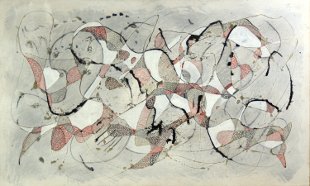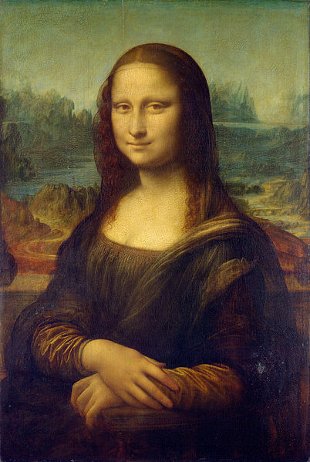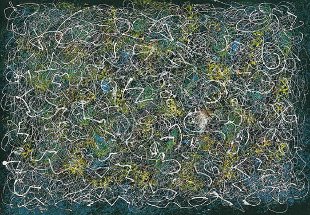
“The Precocious Whispering of Desires”, mixed media, 20 x 12 in. ©David Lee Holcomb, 2013
I just completed a piece of artwork that is both a departure and a return to basics for me. It’s essentially a drawing, scribbles of glue and black ink in layers, each layer painted over with off-white gesso and sanded, then elaborated with textural passages in black ink and red, sepia, and brown watercolor, accented by areas covered in pure white acrylic.
Described like that it sounds pretty mechanical, and in a way that’s exactly what it is.
I generally avoid doing art that might be described as “abstract”. Although I enjoy such work by others, for myself I prefer to remain grounded in the material world whenever possible. A piece like this, however, is about process, rather than an image of something: the mechanical, physical acts involved in creating the thing provide the driving force, rather than some predetermined theme or subject.
Dribbling paint (or ink, or glue, or tar, or whatever) onto a flat surface and then working with the result is hardly a new concept. When Andre Breton, the godfather of the Surrealism movement, finally accepted visual artists into his exclusive little club, one of the techniques that he regarded as most valid was “automatism”, in which random processes — rather than conscious, planned decisions — guided the painter’s hand. In practice, of course, this is impossible, since even if the painter is relying on something as supposedly “random” as dribbling paint, he is still guiding the dribbles onto the canvas instead of the floor, toward or away from each other, toward or away from the edges, etc. — not to mention deciding when to stop.
So is my picture abstract? That’s a word that we use an awful lot in describing art, usually any time we find ourselves unable to see something familiar, concrete. Mirriam Webster defines “abstract” as “relating to or involving general ideas or qualities rather than specific people, objects, or actions”. When something is “abstract”, it is unreal, unbounded by physical reality: “beauty” is abstract, a beautiful woman is not; “nature” is abstract, the tree outside your window is not; “death” is abstract, the departure of a loved one is not.
When we slap paint or tar or glue or whatever onto a surface, we are already moving away from true abstraction: the surface and the medium applied to it are solid physical materials, defined by physical laws that affect what the artist is able to do with them, grounded in the “real”, phenomenological, world.

Leonardo da Vinci, “Mona Lisa (La Gioconda)”, circa 1506
“We should remember that a picture — before being a war horse, a nude woman, or telling some other story — is essentially a flat surface covered with colours arranged in a particular pattern.”
Maurice Denis, Definition of Neotraditionism. Originally published in Art et Critique in Paris, 23 & 30 August 1890
But now we have a problem: if we view the concept of abstraction by this strict interpretation, no plastic art (meaning art created with physical materials, as opposed to singing a song, or playing Hamlet) can be considered truly abstract, and we’ve just lost a century’s worth of art terminology. So let’s unclench a little, close the dictionary, and look at some of the common terms.
*
For the sake of brevity I’m going to leave sculpture, installation, film, and so on out of the discussion now and focus on painting alone: If we take as given that a painting must be physical at some level, or in some degree, most pictures separates out into some basic categories (or sometimes combinations of more than one):
Illusionary — this is a painting that offers what appears to be a window into a three-dimensional space, occupied by physical objects. When we look at the Mona Lisa, we interpret the picture as a woman, sitting in a chair in front of a window or parapet — which is, of course, nonsense: what we’re looking at is nothing more than a thin piece of canvas covered with little smears of colored matter, but with a little effort we have no difficulty suspending our disbelief and recognizing the woman, the chair, and the landscape beyond.
Cubist — this is also illusion, but intellectual, rather than purely visual. While still creating an illusionary three-dimensional space, cubist painting is extremely aware of the flat surface of the canvas, and incorporates that plane into the overall work. The 3-D illusion is never very strong, and the “fake” space depicted is very shallow, never far from the skin of the canvas. In a cubist painting, the representation of the space is more important than the objects that occupy it; it may even be impossible to determine what exactly the artist was looking at — all we see is a kind of schematic of space and volume.
Geometric — here, both objects and the space they occupy have been abandoned. Geometric art depicts mathematical concepts like the square, the circle, and the line, without any effort to provide a visual — illusory — narrative tying the picture to some scene or object existing under “real-world” conditions. We can all agree that pure mathematics are abstract, but what about painting based on math? Well, there’s the rub: a picture of an abstract mathematical form is still a picture of something, so — yes, a circle is an abstract concept, but is a picture of a circle?
Abstract expressionist — this category is a bit of a hybrid of a number of things, a sort of convenient umbrella of the kind popular with art critics that doesn’t necessarily mean a great deal to the artist. At its heart, however, the idea is that the abstract expressionist painting is attempting to depict an emotional or philosophical state — “nature”, “beauty”, “truth”, etc. — without relying on any illusion whatever. Here, the surface of the canvas is embraced, the materials exist as themselves — the paint is simply paint, not part of an apple, or a woman, or a tree — and if the viewer wants the picture to tell a story, he has to come up with it himself. In a sense, an abstract expressionist painting is the least abstract of all: one of Jackson Pollock’s classic “drip” paintings is a picture of paint, and of the process of getting paint onto the surface; no naked women, no bowls of fruit. The paint is there, physical and obvious, not pretending to be a chair or an eyebrow — just paint. If we see something more than that, it’s coming from us, not the artist. [I should mention that many abstract expressionist work do have evocative titles, like “Autumn Rhythm”, or “Vir Heroicus Sublimis”, but these are arbitrary, they label the picture without describing its content.]

Mark Tobey “Night Celebration”, 1971
Color/Energy field — here is another term that means more to people who write about art than to people who do it. “Color field” painting relies on large, usually featureless, areas of pure color, sometimes alone, sometimes a few colors grouped on a single canvas. Drama is introduced by placing particular colors next to each other, or by dividing areas of color with simple linear boundaries, but the colors themselves are the subject of the painting. In “energy field” painting, even color becomes unimportant, and the surface becomes animated by patterns or strokes or squiggles that cover the entire surface, without a single focal point and sometimes without a clear recognition of the edge of the canvas. Energy field painting is usually saved from becoming little more than wallpaper by introducing a certain amount of randomness in the patterning or the type of marks used, so that some areas appear slightly more dense or less dense, like poppy seeds sprinkled onto a piece of paper. While an abstract expressionist may create a painting about the artist’s emotional state while in the process of painting, a color field artist is creating paintings about color and an energy field artist is creating a painting about distributing marks on a surface, again without narrative, without illusion.
*
So. What about my picture (remember where we started?) Is it really abstract?
The word “doodle” is actually a bit of slang, dating from the Great Depression, probably coined in the American Midwest in imitation of a word used by German immigrants, dudeltopf, a simpleton or fool, a “dawdler”. German-Swiss artist Paul Klee spoke of his artistic process as “taking a line for a walk”, which I think is a great definition of a doodle.
I’m going to call it a doodle. The word itself sounds a bit silly, so we tend to shy away from using it to describe a serious work — and the doodle I opened this essay with is, I believe, serious work — but it’s a good word, and it works. A doodle is universal: anyone can do it, we all understand the process; it also adapts itself to a wide range of artistic techniques and styles. You can doodle with color, with line, with shapes; you can create illusions, or avoid them; you can fill up the available space, or wander around in it, drifting over the edges of the page or canvas, or shying away from them. So again: is it abstract? I think it is — there is no overriding concept or visual intention in a doodle, it is its own reason, its own purpose. There’s no attempt to fool the viewer into believing something that isn’t true. Even if there are recognizable images scattered here and there, they have no concrete meaning, they’re just — well, doodles within the doodle.
Is it art? This question I’ll leave for you to decide for yourself.
* * *



Leave a Reply